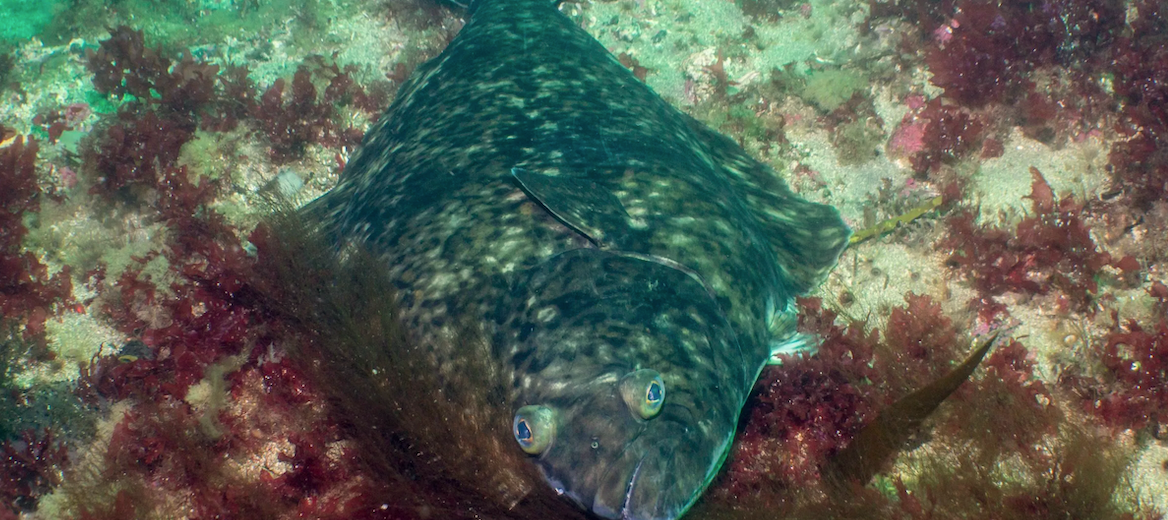
The Atlantic halibut is the largest known flatfish in the world. They belong to a family of fish called righteye flounders (most species lie on the sea bottom on their left sides, with both eyes on their right sides). These flounders prefer temperate and Arctic waters of the northern Atlantic Ocean. Atlantic halibut can be found among the sandy ocean floor at depths of up to 6,560 feet. Less than 10% of their initial population remains, thanks to extreme overfishing. Due to the previously mentioned overfishing, climate change, and pollution these fish are listed as Endangered by the IUCN.
First the Stats…
Scientific name: Hippoglossus hippoglossus
Weight: Up to 515 lbs.
Length: Up to 8.2 feet
Lifespan: Up to 50 years
Now on to the Facts!
1.) These fish are capable of altering their coloration to resemble the sandy bottoms they inhabit.
2.) Their name, broken up as haly (meaning holy) and butte (meaning flat fish), are known for their popularity on Catholic holy days.
3.) Halibut are considered a food fish as well as a sport fish. Much to their dismay.
4.) There are 3 known species of halibut: Atlantic, Greenland, and Pacific.
5.) Halibut are symmetrical at birth with 1 eye on each side of their head. Then, at around 6 months of age, during their larval metamorphosis 1 eye literally migrates to the other side of their head. The eyes are then permanently set once the skull is fully ossified (hardened).
But wait, there’s more on the Atlantic halibut!
6.) Sand lance, salmon, octopus, crab, hermit crabs, worms, lamprey, cod, pollock, sculpin, herring, flounder, and even other halibut are all on the menu. They will literally eat any moving creature that they can fit in their mouth.
7.) Orca, Greenland sharks, and seals all prey on halibut.
Did you know…?
Halibut have what is called countershading. This coloration aids in camouflaging the fish from predators. The dark top side helps them blend in with the ocean floor, while the lighter underbelly helps them blend in with the light from the sky.
8.) Migratory by nature, these fish will relocate from shallow water in the summer to deeper water in the winter.
9.) The halibut fishing season lasts around 8 months but there are IFQs (Individual Fishing Quotas) in place to help sustain the halibut populations.
10.) Fisheries are managed through a treaty between the United States and Canada per the recommendations of the International Pacific Halibut Commission (IPHC), formed in 1923. This commission was created to help halt the inevitable extinction of halibut and adopted a sustainable harvesting method.
But wait, there’s still more on the Atlantic halibut!
11.) Halibut rely on external fertilization (males and females release sperm and egg cells into the water).
12.) Females produce up to 2,000,000 eggs that are then fertilized by the males.
Did you know…?
It is believed that they have evolved their migrating eye as a response to being bottom dwelling creatures. Having both eyes on the upward facing side allows for better prey and predator detection.
13.) The larvae are only about 0.3 inch long and come equipped with an attached yolk sac that is slowly absorbed over around 5 weeks. After which time they switch to eating plankton and eventually other aquatic life.
14.) Once they reach 0.8 inch their body begins to flatten and 1 eye migrates to the right side of their head. Once they reach 1.7 inches, the migrated eye becomes permanently positioned.
15.) All flounders are flatfish, but not all flatfish are flounders. Dwell on that fact, won’t you?
Now a Short Video!
The video is about flatfish, in general.
Be sure to share & comment below! Also, check out the Critter Science YouTube channel. Videos added frequently!
Want to suggest a critter for me to write about? Let me know here.



